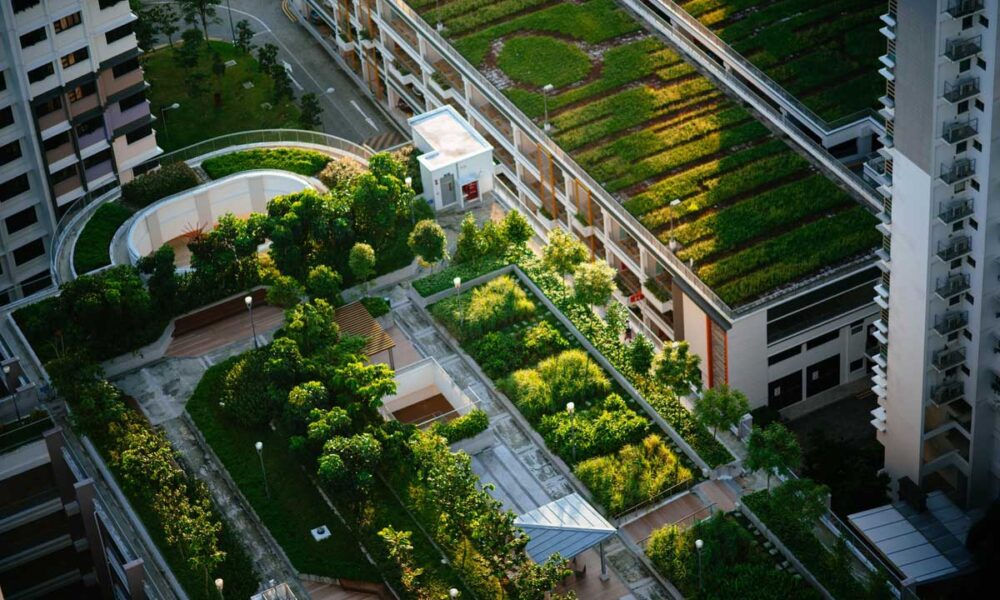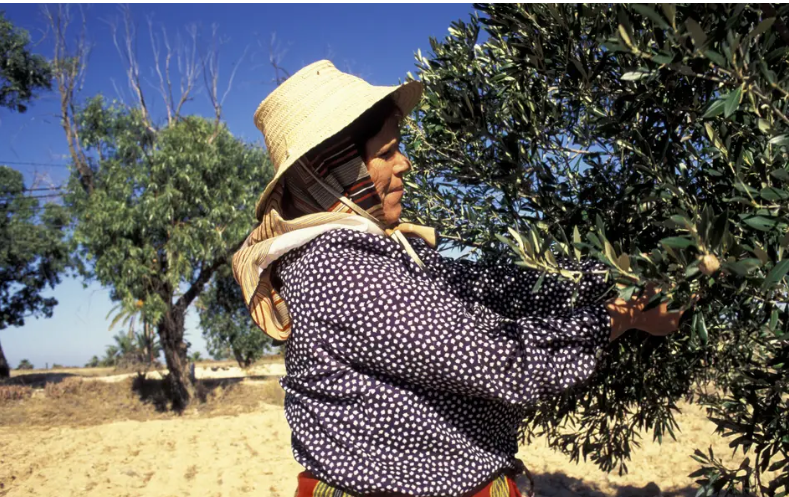BUSINESS & ECONOMY
Global Public Braces for ‘Severe’ Effects of Climate Change by 2032
Published
2 years agoon
By
Editor
Did you know that women represent just 38 per cent of all ocean scientists? A women-led community organisation in the Seaflower UNESCO Biosphere Reserve in the Caribbean, is working to restore some of the most important marine ecosystems in the world and paving the way for bigger women’s representation in ocean science.
Known as ‘the island in the Sea of the Seven Colors’, San Andres is the biggest island in the Seaflower, containing part of one of the richest coral reefs in the world
San Andres itself is a coral island, meaning it was geologically built by organic material derived from skeletons of corals and numerous other animals and plants associated with these colonial organisms. These types of islands are low land, being mostly only a few metres above sea level, surrounded by coconut palms and white coral sand beaches.
It is no coincidence that this Colombian island is a world-class scuba diving destination with crystal clear waters, and a tourist hub visited by over a million people each year.
But being so ‘in demand’ has a key downside: San Andres’ unique ecosystems and natural resources have been deeply impacted. This is something that biologist and professional diver Maria Fernanda Maya has witnessed first-hand.
A community protecting the ocean
“I have seen San Andres change in the past 20 years; the decrease of fish and coral cover has been quite high. Just like the rest of the world, we have experienced a very large demographic explosion, and the pressure on our resources is increasing,” she tells UN News.
Ms. Maya has been diving and working most of her life to protect the treasures of the Seaflower Biosphere Reserve. She is the director of Blue Indigo Foundation, a women-led community organization that works towards the sustainable development of the San Andres Archipelago, and the protection and restoration of its marine ecosystems.
She says she decided to create the foundation because she believes that the local community must lead the protection of its own resources.
“I have worked for many international and national-led environmental projects in the past, and what happens is that people come, do a timed project, and then leave. And then there is no way for the local community to continue it,” the biologist explains.
Ms. Maya works alongside scientific coordinator Mariana Gnecco, who is her partner in the foundation.
“I am an islander; I formed a relationship with the ocean before I was even born. I’ve always known I never want to be far from the sea,” she tells UN News.
Ms. Gnecco has been freediving since she was just 10 years old, and, like Ms. Maya, got her scuba certification before the age of 14 and later graduated from university as a biologist. She is now also pursuing her PhD.
Women in marine science
According to UNESCO, women engage in all aspects of ocean interaction, yet in many parts of the world, women’s contributions – both towards ocean-based livelihoods like fishing, and conservation efforts – are all but invisible as gender inequality persists in the marine industry as well as the field of ocean science.
In fact, women represent just 38 per cent of all ocean scientists and further, there is very little data or in-depth research on the issue of women’s representation in the field
Both Ms. Maya and Ms. Gnecco can attest to this.
“Men are the ones usually leading marine science and when there are women in charge they are always doubted. Somehow, it’s good to have them as assistants, or in the laboratory, but when women lead the projects, I have always felt there is some kind of pushback. When a woman speaks with passion ‘she is getting hysterical’; when a woman makes unconventional decisions, ‘she is crazy’, but when a man does it, it is because ‘he’s a leader’”, denounces Ms. Maya.
She says that because this has been an unwritten truth that women grapple with, she worked hard at the Foundation to create and nurture an atmosphere that is the opposite.
“We have been able to harmonize the work between women and men partners, recognizing, valuing and empowering the feminine forces, as well as what men have to offer,” Ms. Maya stresses.
“Our opinions, our expertise, and our knowledge have been overlooked for so many years that being able to lead a project like this now means a lot. It symbolizes a [a great deal] in terms of equality and inclusion. Although we still have a long way to go because women in science are still undermined a lot of the time, I think we are on the right path to tackle that problem for good,” echoes Ms. Gnecco.
Saving the coral reefs
On the day the Blue Indigo biologists met with the UN News field reporting team, Ms. Maya and Ms. Gnecco braved a non-stop torrential downpour caused by a cold front in San Andres, a common occurrence during the Atlantic hurricane season.
That morning, we thought it might be impossible to report this story because the rain had turned the island’s streets into rivers, and some of the areas we needed to reach had been turned into mud pits.
“And they say women are scared to drive,” Ms. Maya said with a sly laugh when she picked us up on the way to one of the restoration sites they are working on as one of the local implementers of the nationwide project “One Million Corals for Colombia”, that aims to restore 200 hectares of reef across the country.
Earlier that morning, all diving on the island had been halted due to the weather, but conditions (at least on the water) did eventually improve, and authorities turned the red flag yellow.
That news sparked a mini celebration among a group of eager student divers who thought their day was ruined.
Meanwhile, the rest of us put on scuba gear and walked toward the shore in the (still) pouring rain.
“Once you’re underwater, you are going to forget about this grey day. You’ll see!” Ms. Maya said.
And she couldn’t have been more right. After taking the plunge from the rocky (and slippery) coral coast on the west side of the island, we experienced incredible calm beneath the waves.
The visibility was extremely good, and the biologists took us through some of the rope-type coral nurseries they were working on where Acropora coral fragments are growing. We also saw some of the already-transplanted coral within the stunning reef of San Andres.
Blue Indigo Foundation works closely with diving schools on the island, and they contribute to their restoration efforts. The NGO also teaches specialized courses in restoration for international divers several times a year.
“People come over to see our project and learn and they get engaged easier because then they ask us for the coral. ‘Oh, how’s my coral doing? The one we planted on the reef, how’s it doing?’,” Mariana Gnecco explains, adding that when people see the organisms thriving, it helps to raise general awareness.
The corals within the Seaflower Biosphere Reserve have been declining since the 70s, fueled by the rise in the temperature and acidification of the water, caused by excessive carbon emissions and consequent climate change.
“Those are the global threats, but we also have some local threats that are harming the reef, for example, overfishing, bad tourism practices, boat collisions, pollution, and sewage disposal,” underscores Ms. Gnecco.
Raizal people’s efforts and sustainable tourism
By definition, UNESCO Biosphere Reserves are de facto centres for learning about sustainable development. They also provided an opportunity to examine up-close the changes and interactions between social and ecological systems, including the management of biodiversity.
“When a biosphere reserve is declared, it means that it is a special place, not just because of its biodiversity, but also because there’s a community that has a special connection with that biodiversity, a connection that’s been going for decades with a cultural and historical value,” Ms. Gnecco explains.
The Seaflower is very special, she adds, telling us that it comprises 10 per cent of the Caribbean Sea, 75 per cent of Colombia’s coral reefs and that it’s a hotspot for shark conservation.
“The local community – the Raizal people, that have been living here for generations – have learned how to relate to these ecosystems in a healthy and sustainable way. This is our way of living for both Raizal and other residents. We depend completely on this ecosystem and on its biodiversity, that’s why it’s important and special”, the biologist adds.
The Raizal are an Afro-Caribbean ethnic group living in the islands of San Andrés, Providencia and Santa Catalina off the Colombian Caribbean Coast. They are recognized by the Government as one of the Afro-Colombian ethnic groups.
They speak San Andrés-Providencia Creole, one of many English Creoles used in the Caribbean. 20 years ago, the Raizal represented over half of the island’s population. Today, the general population is nearly 80,000, but the Raizal make up about 40 per cent, due to a high migration influx from the mainland.
Raizal Marine Biologist and researcher Alfredo Abril-Howard also works at Blue Indigo foundation.
“Our culture is closely tied to the ocean. The fishermen are the first to notice changes in the coral – for example, they notice that healthy reefs attract more fish. They can describe a vivid picture of the way the reefs looked in the past…no one understands the importance of our reefs better than them,” he underscores.
The expert says that he believes there is a major socioeconomic issue in San Andres: other than tourism, there are very few ways for his people to make a living.
“Tourism keeps growing and most economic activities revolve around it. So, we need more fish because there are more tourists, so now we catch fish of any size affecting the ecosystem”, he says, emphasizing that better tourism management could generate better economic opportunities for locals while letting the reef flourish at the same time.
Mr. Abril-Howard explains that diving, if sustainably managed, can also have an impact on the ecosystem. It can also help to raise awareness about restoration efforts and at the same time give back to the reef.
“We need a change in the way we do our tourism. Restoring our reefs is important, but we also need to make visitors aware that it is there, and that it is not a rock, It is a living being and that they shouldn’t step on it. These are small things that can benefit the future coral cover. We also need to show people that there is more to this island than coming to party and get drunk, so they can learn something,” he says.
A job for ‘superheroes’
For Camilo Leche, also Raizal, coral restoration efforts are now a part of his life as a fisherman.
“I have been fishing for over 30 years. I remember seeing coral bleaching for the first time – you know when coral starts turning white – and thinking that it was because the coral was getting old, like we get white hairs. But now I understand it is because of climate change,” he told us just before going on his morning fishing expedition.
“Before I could see beautiful giant corals around here and it was so easy to find lobster and big fish, now we have to go further and further to find them”, he adds.
Mr. Leche says that he hopes that world leaders can put their ‘hands on their hearts and in their pockets’ to finance more restoration efforts such as the one undertaken by the Foundation, which he now helps.
“I have learned how to fragment corals, to put them in the ropes. We also go out to make the transplants. And those little pieces are now becoming so big and beautiful, when I see them, I feel so proud of it. I feel like a superhero”.
Swimming against the tide
San Andres is not only losing its coral reef cover and fish banks, but the island also faces coastal erosion and is vulnerable to sea level rise and extreme weather events such as hurricanes.
All these are destroying infrastructure and reducing the island’s beautiful beach cover. In some areas, locals say that before they could play a football game in places where only a meter of beach is now seen.
The ecosystems Blue Indigo works to restore are essential to protect the community during extreme weather events.
For example, Colombian scientists were able to prove how the mangrove protected San Andres during hurricanes Eta and Iota in 2020, among other ways by reducing wind speeds by over 60 km/h.
At the same time, coral reefs can reduce by nearly 95 per cent the height of the waves coming from the east of the Caribbean Sea, as well as reduce their strength during storms.
“We know our restoration efforts can’t bring back the coral reef in its totality, because it is such a complex ecosystem. But by growing certain species we can have a positive impact, bring back the fish and ignite these organisms’ natural capacity to restore themselves,” says Blue Indigo chief Maria Fernanda Maya.
For Mariana Gnecco, it is about aiding the reef to survive during a transformation of its environment happening due to climate change.
“What we need is a functional ecosystem. We are trying to at least give it a helping hand so it can adapt to climate change. The ecosystem is going to change, that’s going to happen, but if we help it will happen at least in a way that is not going to die completely”, she says.
Both the UN Decade for Ecosystem Restoration and the UN Decade of Ocean Science for Sustainable Development, both of which began in 2021 and will run until 2030, aim to find transformative ocean science solutions to guarantee a clean, productive and safe ocean, and to restore its marine ecosystems.
According to UNESCO, mainstreaming gender equality throughout the Ocean Science Decade will help ensure that, by 2030, women as much as men will be driving ocean science and management, helping to deliver the ocean we need for a prosperous, sustainable and environmentally secure future.
“The women that are involved in this are paving the path for all the women that are coming behind. Indeed, the future is problematic, and we are swimming against the current, but I think anything that we can do is better than doing nothing.”
That’s Mariana Gnecco’s message to us all.
Related
You may like
-


WEF and UN-Habitat Join Forces to Unlock Critical Investment in Cities through Public-Private Collaboration
-


5 ways countries can adapt to the climate crisis
-


The Development of Artificial Intelligence in China: Conclusions
-


Four ways the planetary crisis is impacting mental health
-


New European Bauhaus under Cohesion Policy: €50 million call for innovative projects in cities
-


The Development of Artificial Intelligence in China: Investment and attention to production
BUSINESS & ECONOMY
In Times of Conflict, Spare a Thought for the Non-Gulf Economies
Published
1 day agoon
May 6, 2024By
Editor
By James Swanston
Positive news for non-GCC Arab economies has been in short supply of late. The Gaza conflict, missile attacks in the Red Sea, war in Ukraine and last month’s tit-for-tat missile strikes between Israel and Iran have weighed on sentiment, undermined limited confidence and cut into growth.
But some positives have emerged. Headline inflation rates have slowed across much of North Africa and the Levant, implying lower interest rates, a return to real growth and more stable exchange rates. March data show inflation at an annualised rate of just 0.9 percent in Morocco and 1.6 percent in Jordan. Tunisia’s inflation rate has also come down, although it is still running at over 7 percent year on year.
Egypt’s inflation rate jumped earlier this year as the government implemented price hikes to some goods and services – notably fuel. In February, the effect of the devaluation in the pound to the level of the parallel market affected prices. But March’s reading eased to an albeit still high 33 percent year on year.
Elsewhere, Lebanon’s inflation slowed to 70 percent year on year in March, the first time it has been in double – rather than triple – digits since early 2020 due to de-facto dollarisation and lower demand for imports. That said, inflation in these economies is vulnerable to increases in the prices of global foods and energy (such as oil) due to their being net importers. If supply chain disruptions persist, it could result in central banks keeping monetary policy tighter with consequences for growth and employment. And in Morocco’s case, it could undermine the Bank Al-Maghrib’s intention to widen the dirham’s trading band and formally adopt an inflation-targeting monetary framework.
The strikes by Iran and Israel undoubtedly marked a dangerous escalation in what up to now had been a proxy war. Thankfully, policymakers across the globe have for the moment worked to de-escalate the situation. Outside the countries directly involved, the most significant spillover has been the disruptions to shipping in the Red Sea and Suez Canal. Many of the major global shipping companies have diverted ships away from the Red Sea due to attacks by Houthi rebels and have instead opted to go around the Cape of Good Hope.
The latest data shows that total freight traffic through the Suez Canal and Bab el-Mandeb Strait is down 60-75 percent since the onset of the hostilities in Gaza in early October. Almost all countries have seen fewer port calls. This could create fresh shortages of some goods imports, hamper production, and put upward pressure on prices.
For Egypt, inflation aside, the shipping disruptions have proven to be a major economic headache. Receipts from the Suez Canal were worth around 2.5 percent of GDP in 2023 – and that was before canal fees were hiked by 15 percent this January. Canal receipts are a major source of hard currency for Egypt and officials have said that revenues are down 40-50 percent compared to levels in early October.
The conflict is also weighing on the crucial tourism sector. Tourism accounts for 5-10 percent of GDP in the economies of North Africa and the Levant and is a critical source of hard currency inflows.
Jordan, where figures are the timeliest, show that tourist arrivals were down over 10 percent year on year between November and January. News of Iranian drones and missiles flying over Jordan imply that these numbers will, unfortunately, have fallen further.
In the case of Egypt, foreign currency revenues – from tourism and the Suez canal – represent more than 6 percent of GDP and are vulnerable. This played a large part in the decision to de-value the pound and hike interest rates aggressively in March.
The saving grace is that the conflict has galvanised geopolitical support for these economies. For Egypt, the aforementioned policy shift was accompanied by an enhanced $8bn IMF deal and, while not strictly bilateral support, the bumper Ras el-Hekma deal seems to have been accelerated as the pressure on the Egyptian economy ratcheted up. This is providing much needed foreign currency. At the same time, Jordan recently renewed its financing arrangement with the IMF for $1.2bn over four years.
Tunisia, however, is an exception. President Saied’s anti-IMF rhetoric and reluctance to pass reforms, such as harsh fiscal consolidation, in an election year, mean that the country’s staff-level agreement for an IMF deal is likely to remain in limbo. If strains on Tunisia’s foreign receipts are stretched, and the central bank and government continue with unorthodox policies of deficit financing, there is a risk that Tunisia’s economic crisis will become messier more quickly in the next year – particularly large sovereign debt repayments are due in early 2025.
James Swanston is Middle East and North Africa economist at London-based Capital Economics
BUSINESS & ECONOMY
Debt Dependency in Africa: the Drivers
Published
2 days agoon
May 6, 2024By
Editor
In mid-April Ghana’s efforts to restructure its sovereign debt came to nothing, increasing the risk that it couldn’t keep up with its repayments. This is a familiar story for many African countries. Twenty of them are in serious debt trouble. Carlos Lopes argues that there are three factors driving this state of affairs: the rules of the international banking system; lenders’ focus on poverty reduction rather than development needs; and unfair treatment by rating agencies.
The debt situation in many African countries has escalated again to a critical juncture. Twenty are in, or at risk of, debt distress. Three pivotal elements significantly contribute to this. Firstly, the rules governing the international banking system favour developed countries and work against the interests of African countries.
Secondly, multilateral financial institutions such as the International Monetary Fund (IMF) and the World Bank focus on poverty alleviation. This is commendable. But it doesn’t address the liquidity crisis countries face. Many don’t have the necessary readily available funds in their coffers to cover urgent development priorities due to their dependency on volatile commodity exports. As a result governments turn to raising sovereign debt under conditions that are among the most unfavourable on the planet. This perpetuates a debt dependency cycle rather than fostering sustainable economic growth.
Thirdly, there’s the significant influence of biased credit rating agencies. These unfairly penalise African countries. In turn, this impedes their ability to attract investment on favourable terms. The convergence of these three factors underscores the imperative to implement effective strategies aimed at mitigating the overwhelming debt burden afflicting African nations. These strategies must address the immediate financial challenges facing countries. They must also lay the groundwork for long-term economic sustainability and equitable development across the continent.
By tackling these issues head-on, a financial environment can be created that fosters growth, empowers local economies, and ensures that African countries have access to the resources they need to thrive.
Rules of the banking game
The Bank for International Settlements is often called the “central bank for central banks”. It sets the regulations and standards for the global banking system. But its rules disproportionately favour developed economies, leading to unfavourable conditions for African countries. For instance, capital adequacy requirements – the amount of money banks must hold in relation to their assets – and other prudential rules may be disproportionately stringent for African markets. This limits lending to stimulate economic growth in less attractive economies.
The bank’s policies also often overlook developing nations’ unique challenges. Following the 2008/2009 financial crisis, the bank introduced a new, tougher set of regulations. Their complexity and stringent requirements have inadvertently accelerated the withdrawal of international banks from Africa.
They have also made it increasingly difficult for global banks to operate profitably in African markets. As a result, many have chosen to scale back their operations, or exit. The withdrawals have reduced competition within the banking sector, limited access to credit for businesses and individuals, and hampered efforts to promote economic growth and development.
The limitations of the new regulations highlight the need for a more nuanced approach to banking regulation. The adverse effects could be mitigated by simplifying the regulations. For example, requirements could be tailored to the specific needs of African economies, and supporting local banks.
Focus on poverty alleviation
Multilateral financial institutions like the IMF and the World Bank play a crucial role in providing financial assistance to many countries on the continent. But their emphasis on poverty alleviation and, more recently, climate finance often overlooks the urgent spending needs. Additionally, the liquidity squeeze facing countries further limits their capacity to prioritise essential expenditure. Wealthy nations enjoy the luxury of lenient regulatory frameworks and ample fiscal space. For their part African countries are left to fend for themselves in an environment rife with predatory lending practices and exploitative economic policies. Among these are sweetheart tax deals which often involving tax exemptions. In addition, illicit financial practices by multinational corporations drain countries of their limited resources. Research by The ONE Campaign found that financial transfers to developing nations plummeted from a peak of US$225 billion in 2014 to just US$51 billion in 2022, the latest year for which data is available. These flows are projected to diminish further.
Alarmingly, the ONE Campaign report stated that more than one in five emerging markets and developing countries allocated more resources to debt servicing in 2022 than they received in external financing. Aid donors have been touting record global aid figures. But nearly one in five aid dollars was directed towards domestic spending hosting migrants or supporting Ukraine. Aid to Africa has stagnated.
This leaves African countries looking for any opportunities to access liquidity, which makes them a prey of debt scavengers. As noted by Columbia University professor José Antonio Ocampo, the Paris Club, the oldest debt-restructuring mechanism still in operation, exclusively addresses sovereign debt owed to its 22 members, primarily OECD countries.
With these limited attempts to address a significant structural problem of pervasive indebtedness it is unfair to stigmatise Africa as if it contracted debt because of its performance or bad management.
Rating agencies
Rating agencies wield significant influence in the global financial landscape. They shape investor sentiment and determine countries’ borrowing costs. However, their assessments are often marked by bias. This is particularly evident in their treatment of African countries. African nations argue that without bias, they should receive higher ratings and lower borrowing costs. In turn this would mean brighter economic prospects as there is a positive correlation between financial development and credit ratings. However, the subjective nature of the assessment system inflates the perception of investment risk in Africa beyond the actual risk of default. This increases the cost of credit.
Some countries have contested ratings. For instance, Zambia rejected Moody’s downgrade in 2015, Namibia appealed a junk status downgrade in 2017 and Tanzania appealed against inaccurate ratings in 2018. Ghana contested ratings by Fitch and Moody’s in 2022, arguing they did not reflect the country’s risk factors. Nigeria and Kenya rejected Moody’s rating downgrades. Both cited a lack of understanding of the domestic environment by rating agencies. They asserted that their fiscal situations and debt were less dire than estimated by Moody’s.
Recent arguments from the Economic Commission for Africa and the African Peer Review Mechanism highlight deteriorating sovereign credit ratings in Africa despite some posting growth patterns above 5% for sustained periods. Their joint report identifies challenges during the rating agencies’ reviews. This includes errors in publishing ratings and commentaries and the location of analysts outside Africa to circumvent regulatory compliance, fees and tax obligations.
A recent UNDP report illuminates a staggering reality: African nations would gain a significant boost in sovereign credit financing if credit ratings were grounded more in economic fundamentals and less in subjective assessments. According to the report’s findings, African countries could access an additional US$31 billion in new financing while saving nearly US$14.2 billion in total interest costs.
These figures might seem modest in the eyes of large investment firms. But they hold immense significance for African economies. If credit ratings accurately reflected economic realities, the 13 countries studied could unlock an extra US$45 billion in funds. This is equivalent to the entire net official development assistance received by sub-Saharan Africa in 2021. These figures underscore the urgent need to address the systemic biases plaguing credit rating assessments in Africa.
Next steps
Debates about Africa’s debt crisis often lean towards solutions centered on compensation. These advocate for increased official development aid, more generous climate finance measures, or the reduction of borrowing costs through hybrid arrangements backed by international financial systems. These measures may offer temporary relief. But they need to be more genuine solutions in light of the three structural challenges facing African countries.
Carlos Lopes,a Professor at the Nelson Mandela School of Public Governance, University of Cape Town, is the Chair of the African Climate Foundation’s Advisory Council as well as its Chairman of the Board. He is also a board member of the World Resources Institute and Climate Works Foundation.
Courtesy: The Conversation
BUSINESS & ECONOMY
IsDB President Advocates for Cultivating Entrepreneurial Leaders
Published
1 week agoon
April 30, 2024By
Editor
By Hafiz M. Ahmed
The 18th Global Islamic Finance Forum recently served as a prominent platform for discussions on advancing Islamic finance and fostering leadership in the entrepreneurial sector. During this notable event, the President of the Islamic Development Bank (IsDB) emphasized the critical need for nurturing entrepreneurial leaders to propel the growth of the Islamic finance industry. This blog post explores the insights shared by the IsDB President, the implications for the future of Islamic finance, and the strategies proposed to develop the next generation of leaders.
Key Highlights from the Forum
The Global Islamic Finance Forum, held annually, brings together experts, policymakers, and stakeholders from across the world to deliberate on the challenges and opportunities within Islamic finance. This year’s focus on entrepreneurial leadership underscores the sector’s evolution and its growing impact on global economies.
The IsDB President’s Vision
- Empowering Entrepreneurs. The IsDB President outlined a vision where empowerment and support for entrepreneurs are paramount. He highlighted the role of Islamic finance in providing ethical and sustainable funding options that align with the principles of Sharia law, offering a robust alternative to conventional financing methods.
- Education and Training. A significant part of the address was dedicated to the importance of education and specialized training in Islamic finance. The President called for enhanced educational programs that not only focus on the technical aspects of Islamic finance but also foster entrepreneurial thinking and leadership skills among students.
- Innovation in Financial Products. Recognizing the rapidly changing financial landscape, the call for innovation in designing financial products that meet the unique needs of modern businesses was emphasized. These innovations should aim to enhance accessibility, affordability, and suitability for diverse entrepreneurial ventures.
- Collaborative Efforts. The IsDB President advocated for increased collaboration between Islamic financial institutions and educational entities to create ecosystems that support and nurture future leaders. This collaboration is essential for developing a holistic environment where aspiring entrepreneurs can thrive.
- Supportive Policies: Lastly, the need for supportive governmental policies that facilitate the growth of Islamic finance was discussed. Such policies should encourage entrepreneurship, particularly in regions where access to financial services is limited.
Implications for the Future
The advocacy for entrepreneurial leaders in Islamic finance is timely, as the industry sees exponential growth and wider acceptance as a viable financial system globally. Cultivating leaders who not only understand the intricacies of Islamic finance but who are also capable of innovative thinking and ethical leadership is crucial for the sustainability and expansion of this sector.
Steps Forward
- Integrating Leadership into Curriculum: Educational institutions offering courses in Islamic finance should integrate leadership training into their curricula.
- Mentorship Programs: Establishing mentorship programs that connect experienced professionals in Islamic finance with emerging leaders.
- Fostering Start-up Ecosystems: Creating supportive environments for start-ups within the Islamic financial framework can encourage practical learning and innovation.
Conclusion
The call by the IsDB President to nurture entrepreneurial leaders in Islamic finance is a step toward ensuring the sector’s robust growth and its contribution to global economic stability. By focusing on education, innovation, and supportive policies, the Islamic finance industry can look forward to a generation of leaders who are well-equipped to navigate the complexities of the modern financial world and who are committed to ethical and sustainable business practices. This vision not only enhances the profile of Islamic finance but also contributes to a more inclusive and balanced global financial ecosystem.

Turkey’s Bold Stand Against Israeli Aggression in Gaza: A Call for Global Solidarity

What is Microtakaful and How Does It Work?

Top 8 Ways Halal Cosmetics Are Reshaping Fashion in 2024
Topics
- AGRIBUSINESS & AGRICULTURE
- BUSINESS & ECONOMY
- DIGITAL ECONOMY & TECHNOLOGY
- EDITORIAL
- ENERGY
- EVENTS & ANNOUNCEMENTS
- HALAL ECONOMY
- HEALTH & EDUCATION
- IN CASE YOU MISSED IT
- INTERNATIONAL POLITICS
- ISLAMIC FINANCE & CAPITAL MARKETS
- KNOWLEDGE CENTRE, CULTURE & INTERVIEWS
- OBITUARY
- OPINION
- PROFILE
- PUBLICATIONS
- SPECIAL FEATURES/ECONOMIC FOOTPRINTS
- SPECIAL REPORTS
- SUSTAINABILITY & CLIMATE CHANGE
- THIS WEEK'S TOP STORIES
- TRENDING
- UNCATEGORIZED
- UNITED NATIONS SDGS
Trending
-

 TRENDING11 months ago
TRENDING11 months agoAFRIEF Congratulates New Zamfara State Governor
-

 PROFILE9 months ago
PROFILE9 months agoA Salutary Tribute to General Ibrahim Badamasi Babangida: Architect of Islamic Finance in Nigeria
-

 BUSINESS & ECONOMY3 years ago
BUSINESS & ECONOMY3 years agoClimate Policy In Indonesia: An Unending Progress For The Future Generation
-

 BUSINESS & ECONOMY3 years ago
BUSINESS & ECONOMY3 years agoThe Climate Crisis is Now ‘Code Red’: We Can’t Afford to Wait Any Longer
-

 BUSINESS & ECONOMY3 years ago
BUSINESS & ECONOMY3 years agoIPCC report: ‘Code red’ for human driven global heating
-

 HALAL ECONOMY10 months ago
HALAL ECONOMY10 months agoRevolutionizing Halal Education Through Technology
-

 BUSINESS & ECONOMY2 years ago
BUSINESS & ECONOMY2 years agoDistributed Infrastructure: A Solution to Africa’s Urbanization
-

 SPECIAL REPORTS4 months ago
SPECIAL REPORTS4 months agoRemembering Maryam Ibrahim Babangida: A Legacy of Grace, Philanthropy, and Leadership

